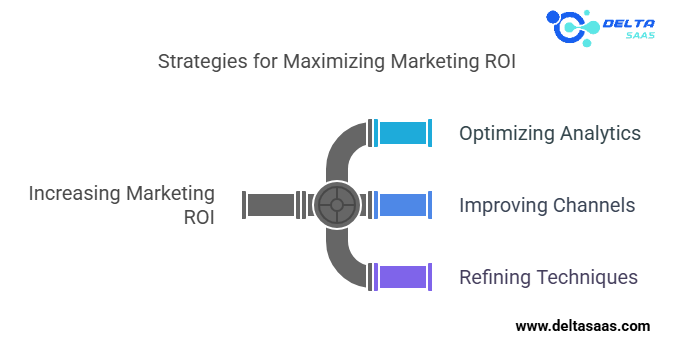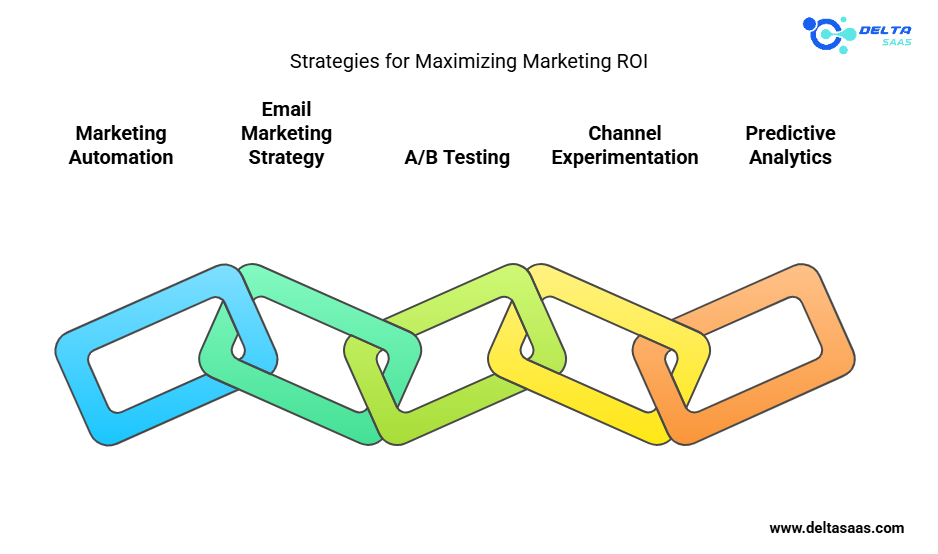
How to Increase ROI in Marketing?
Increasing ROI (Return on Investment) in marketing is one of the most critical goals for businesses. A higher ROI means your marketing efforts yield more revenue relative to the cost, driving efficiency and profitability. But how can you make your campaigns more impactful and ensure every dollar spent delivers maximum results? This guide provides proven strategies to enhance marketing ROI by optimizing analytics, channels, and techniques.
What is ROI in Marketing?
Marketing ROI measures the profitability of marketing efforts. It helps businesses determine whether a specific campaign is worth the investment and where improvements are needed.
ROI Formula for Marketing
To calculate ROI in marketing, use the formula:
ROI (%) = [(Revenue from Campaign – Cost of Campaign) / Cost of Campaign] × 100
For example, if a campaign costs $1,000 and generates $4,000 in revenue, the ROI is:
ROI = [(4,000 – 1,000) / 1,000] × 100 = 300%
This simple formula provides clarity on how well your marketing investment is performing.

Key Takeaways:
- Set Clear Goals: Define KPIs and ROI targets to measure success accurately.
- Use Analytics: Track user behavior and campaign performance to make data-driven decisions.
- Diversify Channels: Experiment with email marketing, SEO, social media, and PPC.
- Leverage Automation: Streamline workflows and personalize customer experiences.
- Focus on Retention: Increase customer lifetime value through loyalty programs and excellent service.
If you’re looking for the best software, check out Delta SaaS, which offers discounts and lifetime deals on SaaS products.
Establish Clear Goals to Boost ROI
Every successful marketing campaign begins with clear, measurable goals. Without goals, it’s impossible to evaluate performance or improve results.
Define Target KPIs
Key Performance Indicators (KPIs) help you track progress and identify areas for optimization. Examples of KPIs include:
- Conversion rate.
- Customer acquisition cost (CAC).
- Customer lifetime value (CLV).
- Average ROI across campaigns.
Set ROI Goals
Establish a specific ROI target for each campaign. For instance, if your current ROI is 200%, test new strategies to increase it by 10–20%.
Pro Tip: Break down goals into smaller milestones to monitor incremental progress.
Leverage Marketing Analytics for Better Decisions
Marketing analytics provides data-driven insights to measure campaign performance and guide decision-making.
Analyze User Behavior
Understanding how users interact with your website, emails, or social media posts is critical. Use tools like Google Analytics, heatmaps, and session recordings to gain actionable insights.
Key Metrics to Analyze:
- Bounce rate: Indicates if users leave your site without interacting.
- Time on page: Reveals how long users stay on specific pages.
- Click-through rate (CTR): Measures the effectiveness of your ads or emails.
Measure Campaign Effectiveness
Track the performance of each campaign and compare it to your goals. Focus on metrics such as:
- Revenue generated per channel.
- Lead-to-customer conversion rate.
- ROI by marketing channel.
Use Predictive Analytics
Predictive analytics leverages historical data to forecast future trends. Tools like HubSpot, Salesforce, and Tableau help predict which campaigns will perform better, allowing you to allocate resources more effectively.
Also Read,
Feedbeo Lifetime Deal – Get Lifetime Access Under $19
Get Minimarks Lifetime Deal: Simplify Bookmarks
NodeLand Lifetime Deal – Maximize Project Efficiency
Stepsy Lifetime Deal – Save Big on Workflow Automation
Agiled Lifetime Deal: Simplify Business Management Today
Apipheny Lifetime Deal – Simplify API Integration

Optimize Your Digital Marketing Strategy
A well-rounded digital marketing strategy can significantly boost ROI by reaching your target audience through the proper channels.
Focus on High-ROI Channels
Specific marketing channels consistently deliver better ROI. For example:
- Email Marketing: Known for its high ROI (up to $42 for every $1 spent).
- Content Marketing: Builds trust, educates users, and drives organic traffic.
- SEO: Improves visibility and drives long-term results without ongoing ad spend.
- Social Media Marketing: Offers affordable options for targeting niche audiences.
Experiment with A/B Testing
A/B testing helps you identify what resonates with your audience—test variables like subject lines, ad creatives, CTAs, and landing pages.
Example:
- Create two versions of an email campaign.
- Test different headlines or images.
- Measure which version generates higher conversions.
Pro Tip: Continuously refine based on test results to maximize performance.
Mobile Optimization
With mobile traffic accounting for a large share of web usage, ensure your campaigns are optimized for mobile devices. This includes:
- Responsive website design.
- Short, mobile-friendly emails.
- Fast-loading pages.
Create Content That Drives Results
Content marketing is one of the most cost-effective ways to increase ROI. It educates, informs, and attracts your audience while improving brand trust.
Use SEO to Drive Traffic
Search Engine Optimization (SEO) ensures your content ranks higher on Google, increasing visibility and driving organic traffic.
SEO Tips for Better ROI:
- Use relevant keywords in titles, headings, and meta descriptions.
- Create high-quality, in-depth blog posts that address user needs.
- Focus on building backlinks to improve authority.
Example: Writing a guide on “How to Measure Marketing ROI” can attract users searching for solutions while showcasing your expertise.
Read More: Social Media Engagement Strategies: Boosting Customer Interaction
Repurpose Content
Maximize the value of your content by repurposing it across multiple platforms. For example:
- Turn a blog post into a video tutorial.
- Create infographics from research data.
- Share excerpts of your blog as social media posts.
Incorporate Interactive Content
Interactive content boosts engagement and provides value to your audience. Examples include:
- ROI calculators to help businesses estimate marketing returns.
- Quizzes that recommend specific products.
- Surveys to gather customer feedback.

Advanced Strategies to Increase ROI in Marketing
Improving your marketing ROI involves refining processes, experimenting with innovative approaches, and leveraging automation and data insights. In this section, we’ll explore advanced techniques, from marketing automation to channel optimization, to maximize returns on your marketing investment.
Leverage Marketing Automation for Efficiency
Marketing automation streamlines repetitive tasks, reduces human error, and enhances the customer experience, which can significantly boost ROI.
Use Marketing Automation Tools
Tools like HubSpot, Marketo, and ActiveCampaign help automate processes such as:
- Sending personalized email campaigns.
- Scheduling social media posts.
- Managing lead nurturing workflows.
Example: Instead of manually following up with leads, create an automated email sequence that triggers when someone downloads a resource from your website.
Read More: Effective Online Advertising Strategies for High ROI
Refine Your Email Marketing Strategy
Email marketing is one of the most cost-effective marketing channels, with a high ROI. To maximize its potential:
- Personalize subject lines and content based on user behavior.
- Segment your audience to deliver relevant messages.
- Use A/B testing for email subject lines, CTAs, and formats.
Pro Tip: Set up cart abandonment emails for e-commerce. These reminders have been proven to recover lost revenue and boost ROI.
Implement A/B Testing Across All Campaigns
A/B testing (split testing) helps identify which strategies work best. To gradually improve campaign performance, test one element at a time.
What to Test:
- Headlines and ad copy.
- Landing page designs.
- Email timings and frequency.
Example: An e-commerce brand could test different product photos to see which generates higher click-through rates on ads.
Experiment with Marketing Channels
Choosing the right marketing channels can make or break your ROI. Experimenting with new platforms and strategies helps you identify where your audience responds best.
Diversify Your Marketing Channels
Don’t rely solely on one channel. Because each audience behaves differently, combining multiple channels maximizes reach and efficiency.
Key Marketing Channels:
- Social Media Marketing: Use platforms like Instagram, LinkedIn, and Facebook for organic and paid campaigns.
- Content Marketing: Publish high-quality blogs, videos, and infographics.
- Pay-Per-Click Advertising (PPC): Use Google Ads to capture intent-driven users.
- Affiliate Marketing: Partner with affiliates to expand your audience and only pay for results.
Pro Tip: Allocate budgets based on past performance. If social media ads generate a higher ROI than PPC, increase your spending there.
Read More: How to Improve Your Online Business for Increased Growth and Sales
Use Predictive Analytics to Choose Channels
Predictive analytics tools, like Salesforce Einstein or Google Analytics 360, help forecast which channels will deliver the best results based on historical data.
Optimize for Mobile Users
More than half of internet traffic now comes from mobile devices, so optimizing campaigns for mobile users is crucial.
- Ensure your website loads in under 3 seconds.
- Use vertical video formats for social media platforms like TikTok and Instagram.
- Simplify your checkout process for mobile e-commerce.
Focus on Customer Lifetime Value (CLV)
ROI doesn’t just come from acquiring new customers—it’s also about maximizing the value of your existing ones. CLV measures the total revenue a customer brings to your business over their lifetime.
Increase CLV with Upselling and Cross-Selling
Upselling encourages customers to purchase a more expensive version of a product, while cross-selling suggests complementary items.
- Example of Upselling: Recommending a premium subscription plan.
- Example of Cross-Selling: Suggesting accessories for a purchased gadget.
Enhance Customer Experience
An excellent customer experience increases loyalty, leading to repeat purchases and referrals.
- Personalize interactions using CRM data.
- Provide stellar customer service through chat support or self-service resources.
- Actively seek and act on customer feedback.
Pro Tip: Use surveys to gauge customer satisfaction and adjust based on their responses. Happy customers are more likely to return and spend more.
Build Customer Loyalty Programs
Loyalty programs incentivize customers to stay with your brand by offering rewards for repeat purchases.
- Offer points that can be redeemed for discounts.
- Give exclusive perks, such as early access to sales or free shipping.
Example: Amazon Prime members receive free shipping, exclusive deals, and video streaming access, encouraging them to continue their subscriptions.
Read More: How to Be Successful in Digital Marketing: Pro Tips
Improve Marketing Efficiency
To boost ROI, focus on improving your marketing efficiency. This will result in more results for the same or lower investment.
Better Budget Management
Analyze your marketing budget to ensure every dollar is spent wisely. Identify underperforming campaigns and reallocate funds to higher-performing ones.
Steps for Better Budget Allocation:
- Review campaign analytics monthly or quarterly.
- Set aside a portion of the budget for testing new strategies.
- Use ROI calculators to predict which campaigns will deliver the best return.
Optimize Your Conversion Funnel
A well-optimized conversion funnel reduces drop-offs and increases ROI.
- Awareness Stage: Attract visitors with SEO, social media, and paid ads.
- Consideration Stage: Use lead magnets like ebooks or webinars to capture email addresses.
- Decision Stage: Offer promotions or free trials to close the sale.
Pro Tip: Use analytics tools to identify where users drop off in the funnel and address those gaps.
Control Over Data with Analytics Tools
Using analytics tools gives you better control over data and helps you make informed decisions. Popular tools include:
- Google Analytics for website performance.
- SEMrush or Ahrefs for SEO insights.
- HubSpot for end-to-end marketing campaign tracking.
Boost ROI with Remarketing Strategies
Remarketing (or retargeting) involves targeting users who have previously interacted with your website or content.
Retargeting with PPC Ads
Set up retargeting campaigns using platforms like Google Ads or Facebook Ads. These ads remind visitors of your brand and encourage them to complete a purchase.
Example: Showing an ad for abandoned cart items to users who didn’t finish their checkout process.
Personalized Email Campaigns
Send personalized emails to users who showed interest but didn’t convert. Offer discounts or additional incentives to drive conversions.
Example: A “We Miss You” email with a 10% discount code for returning customers.
Dynamic Retargeting
Dynamic retargeting uses AI to show personalized ads featuring products users viewed on your site.
Pro Tip: Combine retargeting with A/B testing to refine your ad creatives and messaging further.
Conclusion
Increasing marketing ROI requires strategic planning, data analysis, and ongoing experimentation. Businesses can improve efficiency and profitability by focusing on the proper channels, leveraging analytics, and optimizing every step of the marketing funnel.
By consistently applying these strategies, you can transform your marketing efforts into a reliable growth machine, ensuring that every dollar spent generates measurable value for your business.
FAQs About Increasing ROI in Marketing
Here are the most commonly asked questions about increasing marketing ROI, along with practical answers to help guide your strategy.
How do you measure marketing ROI?
To measure marketing ROI, use this formula:
ROI (%) = [(Revenue from Campaign – Cost of Campaign) / Cost of Campaign] × 100
This formula gives you a percentage value that shows the profitability of your marketing efforts. You can use tools like Google Analytics or a dedicated ROI calculator.
To simplify this process, do marketing strategies have the highest ROI?
Some of the most effective marketing strategies include:
1) Email Marketing: Known for generating up to $42 for every $1 spent.
2)SEO: Delivers consistent, long-term organic traffic.
3)Content Marketing: Builds trust and generates inbound leads.
4)Social Media Marketing: Affordable with strong targeting capabilities when done correctly.
How can you improve ROI in digital marketing?
To improve ROI in digital marketing:
- Leverage marketing automation to streamline workflows.
- Refine your SEO strategy to attract high-intent visitors.
- Use A/B testing to optimize ads, emails, and landing pages.
- Focus on customer retention through loyalty programs.
What is a good ROI for marketing?
A “good” ROI depends on your industry, but a 5:1 ratio (500%) is generally considered strong, meaning you generate $5 in revenue for every $1 spent. A 2:1 ratio (200%) might still be acceptable in some high-growth sectors.
How do you increase ROI in content marketing?
To boost ROI in content marketing:
- Focus on high-value topics that resonate with your audience.
- Use SEO optimization to ensure your content ranks well on search engines.
- Repurpose content into multiple formats (e.g., blogs, videos, infographics).
- Promote your content on the right channels to maximize visibility.
What is the role of marketing analytics in increasing ROI?
Marketing analytics helps you:
- Measure campaign performance accurately.
- Identify high-performing and low-performing channels.
- Understand customer behavior and preferences.
- Make data-driven decisions to optimize your marketing spend.
Analytics tools like Google Analytics, HubSpot, and Tableau are essential for monitoring mOI, CTR, and conversion rates.
How do you calculate ROI for B2B marketing?
For B2B marketing, ROI is calculated using the same formula:
ROI (%) = [(Revenue – Cost) / Cost] × 100
However, in B2B, focus on:
- Lead generation costs.
- Conversion rate from leads to paying clients.
- Customer lifetime value (CLV) to assess long-term profitability.
Why is A/B testing important for ROI?
A/B testing allows you to compare two versions of a campaign element (e.g., ad copy, email subject line) to see which performs better. It improves ROI by ensuring that only the most effective elements are used in your campaigns, reducing waste and increasing conversions.
How does marketing automation improve ROI?
Marketing automation enhances ROI by:
- Reducing time spent on repetitive tasks like email follow-ups.
- Improving lead nurturing with personalized, timely communication.
- Allowing segmentation to target the right audience with relevant offers.
How does customer retention impact ROI?
Customer retention is crucial because acquiring a new customer is often 5x more expensive than retaining an existing one and increasing customer lifetime value (CLV) through repeat purchases, loyalty programs, and excellent service boosts ROI by maximizing revenue from your current customer base.


